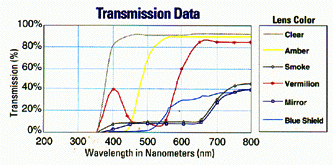INFORMATION ABOUT ULTRA-VIOLET LIGHT
Ultra-violet radiation has two divisions: UV-B radiation (290-315nm) shorter wave lengths and UV-A radiation (315-380nm) longer wave lengths.
Important facts:
- UV can cause photokerato conjunctivitis commonly known as snow blindness
- UV contributes to and accelerates the development of cataracts
- UV can cause corneal degeneration and contributes to the development of pinquecula and pterygium.
- UV can cause degeneration of retinal pigment epithelium which can accelerate age related macular degeneration (ARMD), a major cause of blindness in North America.
- UV can cause tumors of the eyelid known as squamous cell carcinomas which are common and serious.
- UV can also lead to a malignant melonoma which is often fatal.
Protection from UV radiation (both UV-A and UV-B) is very important, especially in light of the earth's depleted ozone layer. Eye tissue does not develop tolerance to UV radiation; thus, no one is immune to its ocular effects. Persons with blonde hair and blue eyes are most vulnerable to UV damage. Damage to eye tissue by repeated exposure to UV radiation is incremental and for the most part irreversible. Some medications can increase sensitivity to UV radiation. Examples of these medications are tranquilizers, diuretics, oral contraceptives, anti-hypertensives, andidiabetics, antibiotics, and antipsychotics. It is recommended that persons taking these or other medications, take extra care in outdoor environments. With this information, one can appreciate the value of UV inhibitors in spectacle lenses.
Spectacle lenses are generally made from three materials: Polycarbonate, Crown Glass, and CR Resin.
Polycarbonate ranks highest in terms of the best safety lenses, followed by CR39 Resins and then a treated Crown Glass lens. The polycarbonate and CR39 resins lenses can have a scratch resistant coating and are about half the weight of crown glass lenses. It is important to note that clear and coated crown glass lenses provide no effective protection from UV radiation. Some solid through the glass tints offer partial UV radiation protection.CR39 resin lenses block UV-B rays and therefore, offer partial protection in their clear lens. A UV inhibitor can be added to block UV-A rays in the CR39 material. Polycarbonate lenses block UV-A and UV-B rays (up to 380 nm) in the clear form.
SOURCES OF UV LIGHT
- Low pressure mercury lamps, such as actinic lamps
- Low pressure mercury lamps, such as fluorescence or "black lights"
- Low pressure mercury lamps, such as germicidal lamps
- Medium pressure lamps, such as photochemical lamps
- High pressure mercury lamps and metal halide lamps, i.e. sun lamps
- High and very high pressure mercury and xenon lamps such as sun lamps, solaria, pulsed lamp systems
- Tanning beds emit a great amount of UV-A radiation
UV LIGHT AND EFFECTS ON THE EYE
The sun radiates energy at higher and lower wave lengths in addition to visible light, much as sounds that can be too high or too low-pitched to hear. Lower-energy radiation can be felt on skin as heat or infrared (IR), beyond the red end of the color spectrum. Too much infrared can be harmful but harmful infrared rays are not as common as the other high energy end of the color spectrum, called ultra-violet or UV. UV means "beyond blue"
Intense ultra-violet sources are common. Examples are sunlight, tanning beds and welding arcs. Fluorescence lights and computer screens are not significant sources of UV light. UV exposure can cause damage in three sites of the eye. Damage can occur on the cornea, where sudden intense UV exposure can cause a "flash burn" making the cornea and iris sore for a day or two similar to a sunburn on the skin. A sore iris can be very painful in bright light. When exposure is excessive, the cornea turns hazy white and could be beyond its ability to heal. This is sometimes referred to as snow blindness. Slower, more chronic UV exposure is believed to promote conditions where membranes around the cornea grow too aggressively, pinguecula and pterygium. All of these conditions need care from an eye professional.
Another area of damage can be the retina, the inner lining that perceives light and is very sensitive to UV radiation. It can develop defects, holes and blisters when exposed to excessive UV light. Retinal problems after cataract surgery were substantially reduced when the FDA approved UV coatings on lens implants.
The third area of concern is the crystalline lens of the eye. The response to long exposure to UV light can result in loss of transparency known commonly as a cataract. The typical cataract has adaptive aspects, protecting the sensitive retina. The lens turns yellow (the best color to block UV rays) and gets milky and becomes more opaque, making reading and vision difficult. Those who work indoors as well as those who spend a great deal of time outdoors are both at risk for cataracts.
Because of these risks, eye protection from UV radiation is of utmost importance, especially to those working outdoors in sunlight, on water, sand, snow, or around arc welding.
Persons who have had cataract surgery should ask the surgeon if the implant is UV protected; if not, special UV protected eye-wear is important.
There is seldom much UV radiation in a vehicle which is why photochromic (polarized) lenses do not get very dark in the vehicle.
The best UV protection is with UV400 lenses with the UV absorber built into the material so it will not scratch off. Eye-wear lenses made of glass are NOT good UV filters.
TRANSMISSION LEVELS 

- UV band goes up to 380 nm
- Our lenses filter out 99% of radiation below 385 nm
- Our UV400 lenses filter out 99% below 400nm and 100% below 380nm
- Maximum UV protection (UV400 lens) is needed only when UV radiation source is significant